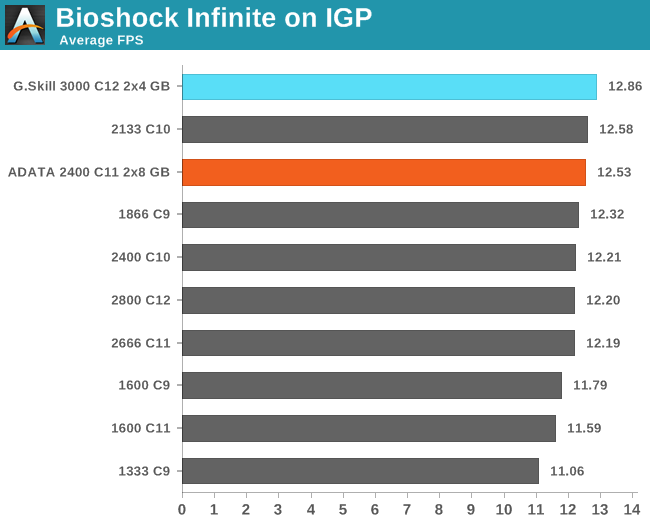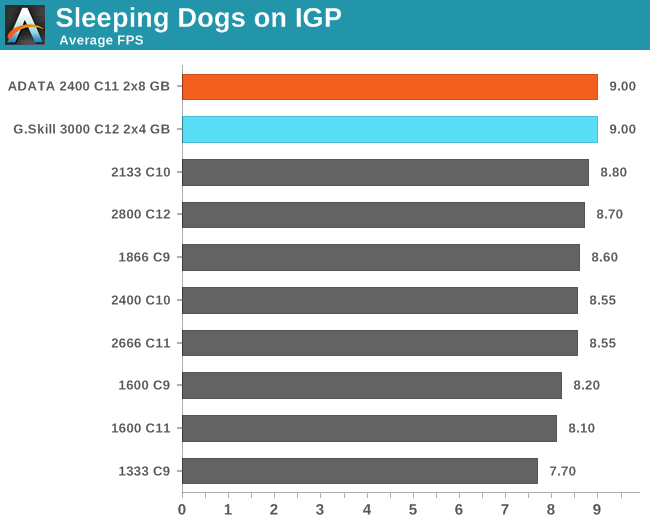ADATA XPG V2 Review: 2x8 GB at DDR3-2400 C11-13-13 1.65 V
by Ian Cutress on November 11, 2013 1:00 PM ESTIGP Gaming
The activity cited most often for improved memory speeds is IGP gaming, and as shown in both of our tests of Crystalwell (4950HQ in CRB, 4750HQ in Clevo W740SU), Intel’s version of Haswell with the 128MB of L4 cache, having big and fast memory seems to help in almost all scenarios, especially when there is access to more and more compute units. In order to pinpoint where exactly the memory helps, we are reporting both average and minimum frame rates from the benchmarks, using the latest Intel drivers available. All benchmarks are also run at 1360x768 due to monitor limitations (and produces more relevant frame rate numbers).
Bioshock Infinite

Tomb Raider

Sleeping Dogs

On IGP, average FPS numbers are some of the best you can get with memory, always being in the top two or three.










23 Comments
View All Comments
The Von Matrices - Monday, November 11, 2013 - link
The silly part is that this is marketed as "gaming" memory while its advantages in gaming on a discrete GPU are minimal. It should be marketed as accelerating applications, which would be a much more reasonable statement. I bought 2400MHz memory not because I play games but because I perform encoding and file compression on my PC, and that is a situation where fast memory makes a difference.As far as making a recommendation on value, Ian stated (and I agree) that memory prices are very volatile. It's basically impossible to make a lasting value comparison on memory because of this. What is a great deal today could be eclipsed next week by a dramatic price decrease of a faster, better product. I agree with Ian omitting a value comparison because it would be pointless a month after the article is posted. However, the performance comparisons of different memory speeds and timings are still of value.
I think the general conclusion he stated is still of value - buy something faster than DDR3-1600 but don't spend too much money because the performance increase is minimal beyond that.
DanNeely - Monday, November 11, 2013 - link
Are any of your planned reviews going to look at the impact of timing relaxation needed to run 4 dimms instead of 2? Having bumped off 12GB a few times I'm now running 18 in my aging i7-920 box; and with both my browsers (Opera, FF) having multi-process upgrades forthcoming that will let them expand beyond the 4GB barrier I've decided on 4x8gb for my new system.The Von Matrices - Monday, November 11, 2013 - link
I don't understand why you're creating a new term "performance index" instead of just using the more standard time to first word (in ns). It would behave exactly in reverse to your "performance index" with lower times being better but otherwise the comparison would be the same.ShieTar - Tuesday, November 12, 2013 - link
I agree. Its not only more standard, it is also physically more meaningful, and can be adapted to describe the performance of software with known algorithms E.g. if your ramdisk is reading 512-Byte-sectors from memory, its performance will scale with the "time to get a full sector".But of course, frequency is also a much more useful parameter to distinguish electromagnetic signal than wavelength, and you still can't get anybody who learned their field on wavelength to give it up. Once people start to think within certain terms, they are very stubborn about changing definitions.
whyso - Monday, November 11, 2013 - link
If you run IGP benchmarks can you please run at something relevant? 11 fps is not relevant.cmdrdredd - Monday, November 11, 2013 - link
Still with these big heatsinks on the memory? I almost have to use the low profile Samsung stuff because of my Noctua cooler not allowing much clearance.meacupla - Monday, November 11, 2013 - link
I think these unnecessarily tall RAM heatsinks are still being made, because the manufacturers think people will use CLC CPU coolers instead of a dual tower heatsink.or maybe they think the only people who will buy this type of RAM are people with real water cooling loops.
or maybe they are for LNG overclocking contests or something.
Either way, if the customer is sensible enough to buy a tower heatsink in the first place, I'm sure they would also be sensible and buy some lower profile, 1600Mhz or 1866Mhz CAS8 or CAS9 RAM, instead of overkill 2400Mhz.
DanNeely - Tuesday, November 12, 2013 - link
giant ramsinks long predate CLCs. For that matter I'm fairly sure they predate tower style heatsinks as well.Hood6558 - Wednesday, November 13, 2013 - link
Overkill is best, sensible decisions are for Grandma's email machine...Kamus - Tuesday, November 12, 2013 - link
Some battlefield 4 tests would've been nice... According to corsair, 2400 memory was giving up to 20% better performance than 1333.mbut I've yet to see another test like that one to corroborate.